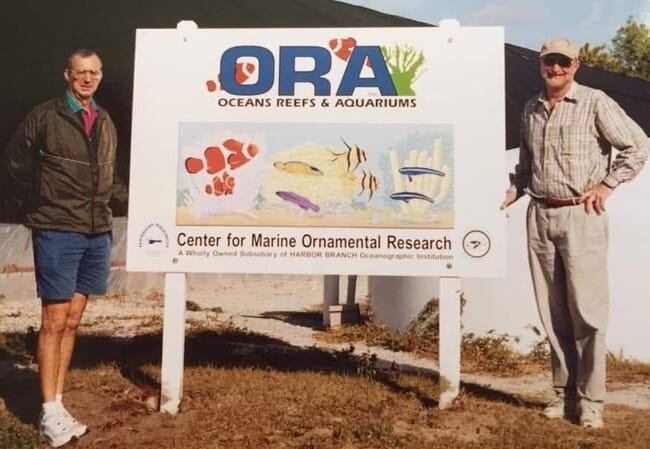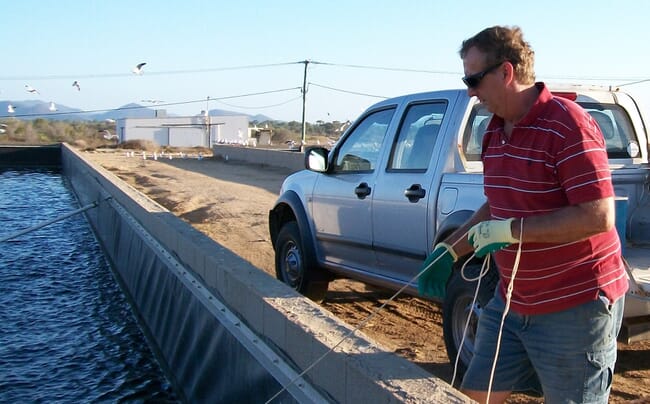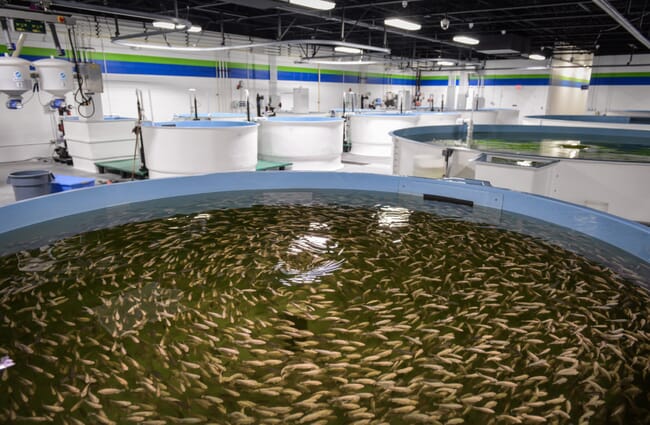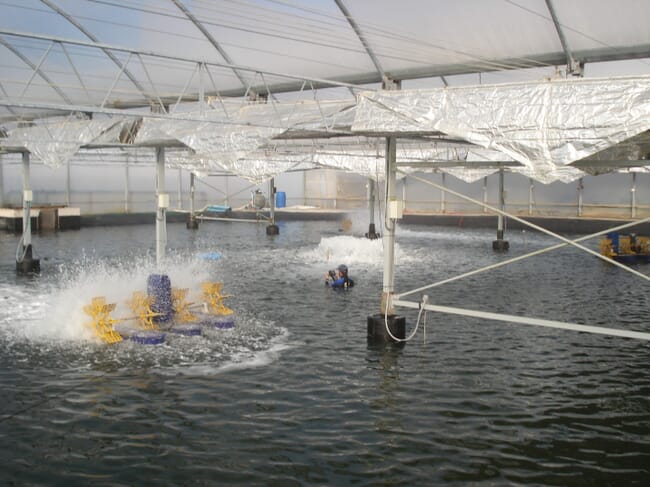
After nearly 50 years in aquaculture – including stints spent managing several RAS facilities – Andrew Leingang decided to ask a panel of experts exactly what factors should be taken into account by anyone considering establishing a RAS. In the first instalment of a two-part article, he offers some valuable insights into the world of recirc, including how to attract finance and key factors to consider in terms of setting up the system.
Introduction
Aquaculture has been around for centuries. Although it is still largely a pond and cage industry, recirculating aquaculture systems (RAS) have advanced over the past 40 years to become an increasingly viable option for a range of species and life stages. RAS are challenging, exciting, and many see them as the only way to ensure future world seafood security.
Some of the many benefits of RAS include the ability to locate close to population centres and markets, the ability to control temperature for year-round production, and the avoidance of weather extremes. RAS make it possible to raise fish in any climate and location. No matter the temperature outside, it should always be optimal inside the facility. Seasonal water temperature variations will not dictate growing seasons, and daily water temperature fluctuations will not stress fish, thereby reducing disease and mortality. RAS optimise temperature control for both warm and cold water species. And because the water is recirculated, heating and cooling costs are reduced. Growing marine fish away from the coast, done. Growing fish near big cities, done. The caveat is that sufficient good quality water must be available nearby or shipped-in for make-up water or emergencies.
The downsides include high initial costs and high risks due to high stocking densities – mechanical or human error, can lead to potential losses of stocks and money. RAS are not immune to natural disasters, of course, which can have a negative or devastating impact. Disaster events can cause road closures, power disruptions, delayed feed and liquid oxygen deliveries and staff absenteeism.
Fishponds and cages have not changed much over the years, and are fairly uniform in design. RAS are diverse and are constantly changing, with new technology developed around the world. There are many successful RAS businesses, but in the past, many more failures than successes.
It all starts with the efficient and economical performance of the system.
I am not going to compare RAS systems specifically, as the information would quickly become outdated. I don't represent any RAS brands. I reached out to some RAS designers for their comments. There are many well-establish and reputable firms. Although the physics, chemistry, and biology behind RAS are the same, RAS designs and equipment are varied and reflect the vision of the RAS designers themselves.
RAS is essential for certain areas in aquaculture, especially for marine fish. Broodstock and juvenile production would be difficult and sub-optimal if carried out in flow-through or static systems (ponds and cages). RAS grow-out has its benefits, but also extreme high-risks, as key elements (oxygen and filtration) are subject to catastrophic failures.
Extensive and semi-intensive outdoor ponds, raceways, lake and sea cage production, will always be the least cost and lowest risk. But these systems have risks too, such as oxygen depletions, predators, disease, algae that produces toxins or off-flavours, storms, theft and limited growing seasons.
It doesn't matter if you are planning a small backyard RAS or a multi-million dollar facility, these “Do's and Don'ts” from industry experts will be invaluable.
You will not find all the answers to your RAS questions here. You may find more questions, questions that are unique to your business. Only you can find the answers. But I am sure the ideas presented here will be helpful.
Before we start, I’d like to clarify that I use the words "fish" and "species" to cover any aquaculture crops, including plants. My thoughts will begin each section, while our expert contributor's recommendations are inserted in italics. Let us begin!

Sales
Like most successful businesses, we should start at the end, and not at the beginning. Many are enamoured with the new shiny RAS, the animals, the metrics of production, costs and efficiency. But what about customers, farm gate prices and seasonal price fluctuations? Assumptions – such as the highest and lowest sales prices, estimated volumes the market can handle and competition – are just assumptions. Using inaccurate farm gate prices to predict profit/loss is dangerous.
Once the sales price and volumes are established, then the size of the RAS facility, water volumes, and production goals can be determined. Too many business plans work off a breakeven figure. Breakeven is too close to a loss. If there is not much chance of making a profit, then it is wise not to proceed.
Remember you can lose your customers anytime to cheap imports, even if your product is superior. Find a species or product form (for example, live, or further processed), that is partially immune to local and international competitors.
As Ben Pohlner, an Australian-based aquaculture and environmental consultant for project planning, design, and operation, explains: “Marketing and sales can be a nightmare. Just accept that for the bulk of your product, you will be a price taker, not a price maker. Do your research on auction floor prices over at least a decade, this will give you a good feel for the baseline price of your product. Use this in modeling and budgets. You may find some niche markets for smaller volumes, but you want to know what the bottom line is at maximum production.”
Philip Lim Kok Wee, director of seafood trading and an aquaculture consultant based in Kuala Lumpur, adds: “Traditionally, it is recommended to be competitive in the marketplace, use the 4P's: Product branding, Price, Place, and Promotion. We should now add Support to become the 4P’s + 1S!”
“What product values are being missed in your target audience? Species, sizes, reliability, freshness, packaging, texture, taste, volume, and value added, should all be considered,” argues Dr James Steeby, an extension aquaculture specialist with over 40 years’ experience in the US catfish industry.
Financing and starting up
Some people are good at raising money, but can't raise fish. Some can raise fish, but not capital. Without adequate startup funding, projects are doomed to fail, either before they get started, halfway through construction, or during the first year of operation. Remember you need capital, not just for construction, but also for operating expenses and contingency funds for emergencies and delays to harvest and sales. And don't forget interest and return on partner investments. And if you are going to do it, do it right! Short cuts and cost cuts may make sense in the initial construction, but must be "paid back" forever in excessive costs, retro-fittings, loss of production, and staff morale, trying to manage the unmanageable.
If you want to borrow $500,000 to start a RAS, venture capitalists will not be interested. If you need $5 million to invest in a RAS, they might be happy to fund, because they believe high-risk ventures mean high returns.
And do not forget insurance. Public indemnity and product liability, workmen's compensation, and loss by fire, theft, and natural disasters. Stock insurance depends on cost (which can be prohibitive) and finding companies who insure aquaculture losses.
As Werner Gaus, who is based in China and has been developing RAS systems world-wide for over 30 years, explains: “RAS aquaculture is the fastest growing industry globally. Newcomers must consider quality above inexpensive designs and equipment, as anticipated fast ROI's are not reached with quick fixes. There are sadly only two currencies to pay for our mistakes: Time and money!"
While attracting investment is important, it’s essential to ensure that you bring the right investors onboard.
“The worst-case scenario is a bunch of investors with little or no experience trying to run an aquaculture facility. Make sure someone in the group has years of experience with a commercial RAS. If not, find someone, or don't do it. Prepare the financial modeling using actual data from an existing facility: find out, no matter what the cost! With this information, double the costs and halve the income. If it is still viable then it is time to examine the project further. Anything and everything in aquaculture is super high-risk. You need big margins to counter for potential big losses along the way,” explains Pohlner.

© Dennis Delong
Systems
Public aquariums house a vast variety of species. They utilise life support systems (LSS). The number and biomass of fish and invertebrates are relatively small compared to RAS, but with the added challenge of keeping the water clear for public viewing. RAS are actually growth support systems (GSS). The difference is the amount of feed, the biomass that must be supported, and the filtration needed to remove the corresponding waste material.
There a so many options for RAS today. Each designer has a history of systems they have developed, discarded or are under development. After deciding to invest in RAS, it can be confusing which company to go with. Don't put all your faith and money in a "turnkey system" without first doing your homework. Find out everything about all the systems available.
Don't just visit an RAS showroom to see the scale models and/or the engineering drawings for their system. Ask to see several commercial systems in production, and have access to the owners and operators. If they only have written testimonials, and no actual site visits to interview operators, move on to another designer.
The RAS designers should be available for advice and problem-solving. However, after the system is constructed and commissioned, production, risk management and profitability are up to you.
When things go wrong, and they will occasionally, who is to blame? Operators will blame the system; RAS designers will blame the operator. Sometimes both are correct. Pitfalls are around every corner, and risks must be recognised beforehand, and then managed to ensure success. You do not have to know all the science and engineering that goes into RAS, but you must be an expert operator, knowing what to do, and when to call for reinforcements. However, usually, you won't have time to get help.
As an operator, it is easy to fall into the trap of just concentrating on feeding and water quality. Yes, these two factors are important. Overfeeding means bad water quality. Bad water quality means poor feeding activity, slow growth, and possible disease and mortality.
Remember, RAS produces three things: fish, bacteria, and waste. You have to keep the proper bacteria alive and remove/dispose of solid wastes (sludge). Neglect of these two things will negatively impact fish production.
To maximise temperature control in the building, walls and ceilings should be well insulated, which will reduce heating and cooling costs. Condensation on all surfaces will be a problem when extremes of outside and inside temperatures are present. Mould will form and must be removed for staff safety. Condensation can be reduced by ceiling fans, which remove excess water vapour.
It is preferred to have multiple RAS units within the same building or have multiple buildings, so that individual systems may periodically go through a dry out, while production continues in other systems. If disease problems occur and cannot be controlled by normal chemical treatments, a total facility dry out may be required. This will result in a major loss of time as the biological filters must be re-started before fish are restocked.
“Round, square, or hexagon; small or large; shallow or deep; different tanks all have their pros and cons. Price and footprints are usually the basis of choice and not efficiency. Big tanks at low densities have a higher ratio of water to individuals. Small tanks at high densities have less water. When calculating flow rates, remember the water displacement of the standing crop. It's difficult to compare the tank turnover for one RAS to another by just size, shape, and volume,” explains Gaus.
It’s also important to design the practicalities of the design and ensuring it can accommodate a degree of human or mechanical error.
“A major part of the biological plan design is to know theoretically what a system can produce and build accordingly with enough margin for error. Consider the handling of fish in the design stage and not as an afterthought,” reflects Christine Huynh, a Tasmania-based Aquaculture Entrepreneur, who previously directed a major RAS farm in the US.
“Don't bury pipes or put pipes under concrete. Open plumbing is easier to maintain and retro-fit down the track. Make sure that the outlet pipe is at least double the diameter of any inlet pipes. Inlet comes in under pressure, but the outlet is under gravity hence the need for a bigger pipe. Find the weakest link in your system and work to minimize that risk,” Pohlner adds.

© Dr Bill McGraw
An understanding of the chemistry at play in an RAS is also useful, as it helps to decide where and how to minimise risks.
“The most critical factor will always be dangerously low dissolved oxygen because any fail here will result in biomass loss throughout the system, both fish and biofilter bacteria. Another factor is hydrogen sulphide, which is produced in anoxic areas in the biofilter. Even at low concentrations, it is toxic. Heavy metal accumulation in the systems and the fish, must be measured and removed. You should always have two ways to do deal with critical factors; for example, you should have liquid oxygen (LOX) available should the oxygen generator fail,” explains Jorge Lizari, a Chilean who is currently managing RAS facilities in the Middle East.
Overengineering certain components can also be worthwhile, according to Hawaii-based Prof Kevin Hopkins, who has been teaching aquaculture for 32 years.
“The dynamic head when using gravity to move water from the tank to filters and sumps is typically extremely low. Oversize your pipes and fittings. Oversize pipes and fittings on the pressurised side of the system. It reduces pump size and energy costs for little money,” he says.
In the second part of the article, which is due to be published next week, we will cover equipment, staffing, operations, species, water quality, and fish health.



